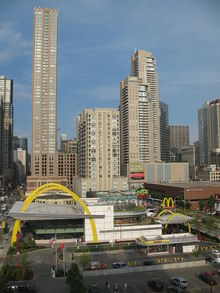How well is "Golden Arch" positioned in Switzerland?
In 2001, McDonald's launched a new venture by opening two hotels in Switzerland (Zurich and Lully) under the name "Golden Arch Hotel." The hotels were positioned as four-star accommodations with cutting-edge in-room technology and unique, modern interior design. Testimonials of guests were mixed following their stays in the Golden Arch Hotels. Most seemed to agree, however, that the four-star rating didn't seem to match with McDonald's image.
____________________________________________________________________
The Golden Arches are the symbol of McDonald's, the global fast-food hamburger chain. Originally, real arches were part of the restaurant design. They were incorporated into the chain's logo in 1962, which resembled a stylized restaurant, and in the current Golden Arches logo, introduced 1968, resembling an "M" for "McDonald's".
Given the saturated world hamburger market, McDonald's headquarters in Chicago had decided to launch a "diversification" strategy to foster new ideas and concepts worldwide. Urs Hammer, McDonald's Switzerland long-time CEO, proposed a foray into the hotel business building on McDonald's image of cleanliness and fast, friendly service. With McDonald's strong global brand recognition and the transferable competencies from restaurant to hospitality, Hammer was convinced the project would be a success.
The hotel market in Zurich was booming with multiple building projects under way. The growth was happening so rapidly, in fact, that analysts predicted overcapacity in the very near future. In a fiercely competitive hotel market, Golden Arch Hotels was faced with the challenge of how to profitably target the key customer segments: travel groups, business travelers, and frequent travelers (FITs). With only two locations in one highly competitive country, how well is Golden Arch positioned in Switzerland, and how can the model be expanded and launched throughout the world?
____________________________________________________________________
The Golden Arches are the symbol of McDonald's, the global fast-food hamburger chain. Originally, real arches were part of the restaurant design. They were incorporated into the chain's logo in 1962, which resembled a stylized restaurant, and in the current Golden Arches logo, introduced 1968, resembling an "M" for "McDonald's".
The arches were introduced in 1953, when Richard and Maurice McDonald were building their first franchised outlet in Phoenix, Arizona. Architect Stanley Meston designed a walk-up hamburger stand with red and white tiles and a distinctive sloped roof, but Richard, wanting more visual appeal, sketched a pair of stylized yellow arches, one at each side. Meston accepted other changes but rejected the arches; in the end, sign-maker George Dexter was hired to construct the arches. When viewed from an angle, the two yellow arches design was reminiscent of the two loops forming the letter "M" for McDonald's. A sign out front incorporated yet a third yellow arch along with the chain's signature character, a chef named Speedee.
In 1962, seeking to upgrade its image, the company sought a new logo. Fred Turner sketched a stylized "V", but the company's head of engineering and design, Jim Schindler, extended the "V" into an "M" resembling a McDonald's store viewed from an angle, with a red isosceles trapezoid "roof" serving as background for lettering.
While McDonald's dropped the physical arches from nearly all of its restaurants in the 1960s, the Golden Arches have remained in the logo, and as a commonly understood term for the company. All McDonald's stores and commercials in Canada have a maple leaf in the middle of the Golden Arches.
They have also been seen more broadly as a symbol of capitalism or globalization, since they are one of the more prominentAmerican corporations that have become global in their reach (along with Coca-Cola and Nike).
The Golden Arches theory
Main article: List of countries with McDonald's franchises#Golden Arches Theory of Conflict Prevention
In his book The Lexus and the Olive Tree, Thomas L. Friedman proposed The Golden Arches Theory of Conflict Prevention, also known as "the McDonald's Doctrine", observing that no two countries with a McDonald's franchise had ever gone to war with one another, a version of the democratic peace theory. The argument goes that when a country has reached an economic development where it has a middle class strong enough to support a McDonalds network, it will not be interested in fighting wars anymore. The theory was false as soon as it hit print, as the United States invasion of Panama was one of the first such conflicts. Shortly after the book was published, the NATO bombing of Serbia again proved the theory wrong, though in a later edition Friedman argued that this exception proved the rule: the war ended quickly, he argued, partly because the Serbian population did not want to lose their place in a global system "symbolised by McDonald's" (Friedman 2000: 252–253). Friedman framed this theory in terms of McDonald's Golden Arches "with tongue slightly in cheek" (Friedman 2005). Recently, Friedman has updated the theory with the Dell Theory of Conflict Prevention (Friedman 2005). In 1999, McDonald's host countries India and Pakistan fought a war over the Kashmir Border. Though the war was not fought in all theatres (such as Rajasthan and Punjab borders), both countries had moblised their military all along the border and both countries also flaunted their nuclear capabilities. At least two wars between McDonald's hosting nations have occurred since the NATO bombing of Serbia: the 2006 war between Israel and Lebanon; and the 2008 conflict between Georgia and Russia over South Ossetia.
Fuente: wikipedia





